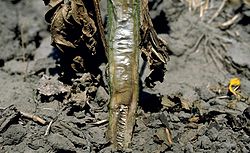Verticillium
Verticillium is a genus of fungi that are responsible for causing the plant disease verticillium wilts.[1]
| Verticillium | |
|---|---|

| |
| Verticillium theobromae culture | |
| Scientific classification | |
| Kingdom: | Fungi
|
| Division: | Ascomycota
|
| Class: | Sordariomycetes
|
| Order: | Glomerellales
|
| Family: | Plectosphaerellaceae
|
| Genus: | Verticillium
|
Appearance
Fungi of this genus are largely lightly coloured. Some areas on them may be darker due to pigments being made.[2] The group is named Verticillium after the “verticillate” (meaning whorled) shape of their asexual reproductive organs (conidia).[3]
Other than this shared feature, the fungi in this group are often very unlike each other. Verticillium dahliae has dark pigmented storage organs while Verticillium afalfalfae has a dark pigmented mycelium as a resting stage in between hosts.[2]
Habitat
Most members of this group live in the temperate or subtropical regions. A few species such as V. dahliae are also found in the tropics as well.[3]
Classification
There are ten known species in the genus Verticillium.[1]
Disease
Verticillium fungi cause the plant disease verticillium wilts.[2][1] This disease has been reported in over 200 host plant species including; fruit, flowers, oilseed crops, cereal crops, and trees.[3]
The fungus lives in the soil and infects plants by entering through their roots.[4][3] Once in the plant, the fungus will live in the plant’s water vessels (called Xylem). This causes disruption to the plant’s ability to transport water. Less water results in the plant wilting and turning yellow. Plants infected with Verticillium species will produce lower crop yields.[3]
The different Verticillium species infect different crop plants. V. dahliae is especially damaging to beets, strawberries, and potatoes yields, while V. longisporum infects rapeseed.[4] V. albo-atrum is known to cause a lot of damage to hops monocultures. Especially when farmers fertilise their fields with the leftovers of last year's hop harvest. This is because the fungus can survive in the stored hops so by adding them as fertiliser, the farmer accidentally infects their new crops.[4]
It has also been reported that the round worm parasites that feed on the plants make infection more likely. It is not thought that the round worms carry the fungus but instead they make holes in the plant when they eat. This allows the fungi to get inside easier.[3] The plant then has two problems (worms and fungi) and cannot fight both at the same time so dies faster.[3]
A big problem with Verticillium fungi is that they are difficult to kill using fungicides, ultraviolet light, and high (or low) temperatures.[5] Also, no one has made effective fungicides or crops that can survive infection.[4] The best way to avoid infection is to have good crop rotation (never plant the same crop in the same field two or more years in a row). Planting the crops at a different time in the year can also reduce the number of infections.[4]
References
- ↑ 1.0 1.1 1.2 Chen, Jie-Yin; Klosterman, Steven J.; Hu, Xiao-Ping; Dai, Xiao-Feng; Subbarao, Krishna V. (2021-08-25). "Key Insights and Research Prospects at the Dawn of the Population Genomics Era for Verticillium dahliae". Annual Review of Phytopathology. 59 (1): 31–51. doi:10.1146/annurev-phyto-020620-121925. ISSN 0066-4286. PMID 33891830.
- ↑ 2.0 2.1 2.2 Inderbitzin, Patrik; Bostock, Richard M.; Davis, R. Michael; Usami, Toshiyuki; Platt, Harold W.; Subbarao, Krishna V. (2011-12-07). "Phylogenetics and Taxonomy of the Fungal Vascular Wilt Pathogen Verticillium, with the Descriptions of Five New Species". PLOS ONE. 6 (12): e28341. doi:10.1371/journal.pone.0028341. ISSN 1932-6203. PMC 3233568. PMID 22174791.
- ↑ 3.0 3.1 3.2 3.3 3.4 3.5 3.6 Fradin, Emilie F.; Thomma, Bart P. H. J. (March 2006). "Physiology and molecular aspects of Verticillium wilt diseases caused by V. dahliae and V. albo-atrum". Molecular Plant Pathology. 7 (2): 71–86. doi:10.1111/j.1364-3703.2006.00323.x. ISSN 1464-6722. PMID 20507429.
- ↑ 4.0 4.1 4.2 4.3 4.4 Heupel, Monika (2013). "Verticillium diseases in Germany - history, significance and management". 11th International Verticillium Symposium: 17–18.
- ↑
Verticillium Media
Verticillium conidiophores
Bell, A A; Wheeler, M H (September 1986). "Biosynthesis and Functions of Fungal Melanins". Annual Review of Phytopathology. 24 (1): 411–451. doi:10.1146/annurev.py.24.090186.002211. ISSN 0066-4286.



